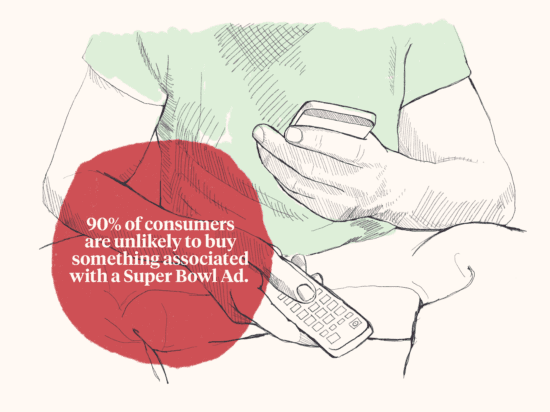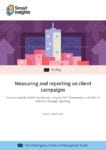Rather than stubbornly sticking with broad strategies aimed at increasing general awareness, marketers can make an impact by embracing a targeted approach via 'relevant awareness'
More than 40 brands purchased and ran national television spots that aired during the 2019 Super Bowl. Each advertiser paid at least $5 million per spot - not accounting for the costs associated with producing and shooting a major TV commercial.
What made that investment worthwhile? Well, the ads reached more than 114 million viewers that night. That's certainly impressive on the surface.
Those eyeballs are great, but a study by Genesis Media found that 90% of consumers are unlikely to buy something associated with a Super Bowl ad. This means that at a CPM (cost per thousand viewers) of $44, each of those 40 brands wasted at least $4.5 million pushing products to viewers who just didn’t care.
Good marketers, bad metrics
The PR industry has been around for more than a century. Over those many years, the prevailing belief has been that the more people you hit with a message, the better. Marketers who started their practices in traditional or mass channels such as PR, print, or broadcast might still treat impression counts as not merely a critical KPI but the critical KPI when measuring the success of campaigns.

The marketing landscape has changed over the years, though. Technological advancements offer improved data analytics and targeting capabilities, and the industry has a growing emphasis on strategy. Modern marketers must understand that impressions alone do not matter. Unless you know who the viewer is and how those impressions are contributing to your sales pipeline, chasing them is a waste of money.
That’s not to say that awareness is dead by any means. Rather, it’s time for marketers to take a more thoughtful and analytical approach.
Awareness that matters
Instead of using an overly broad strategy aimed at increasing awareness, marketers can make an impact by being more targeted. The goal should be generating "relevant awareness," which involves reaching only buyers or customers who are relevant to your sales pipeline — the ones who would actually care if they saw a Super Bowl ad featuring your logo.
Apart from the cost savings that result from only trying to reach interested audiences, advanced targeting ads yield a more than 240% increase in ad engagement and a cost-per-click reduction of more than 70%. This type of efficiency makes you more flexible, effective, and creative.
Relevant impressions give you a sense of how large your reachable market is and how much growth opportunity still exists. But that's only the start of the story.
Ask the right questions
To understand how the relevant awareness you generate directly contributes to your sales pipeline, you need to follow all impressions through that pipeline and down the remainder of the sales funnel.

For example, imagine you’ve generated one million relevant impressions targeting your specific buyer profile. That's great! Now what? There are several questions you should ask yourself, including:
- How many actually engaged with your ad? Is that number higher or lower than the industry average for that channel? Of those, how many clicked through to your website or visited it later?
- How many people who did visit your site took a valuable action, like searching for deeper content, downloading a case study, or watching a product video? How many came back after leaving?
- How many signed up to receive marketing emails? Of those, how many opened the emails?
- How many interacted with your contact form or shopping cart?
- How many turned into leads? Most importantly, how many turned into sales?
If you’re constantly tracking and measuring engagement at each step along the customer journey, then you’ll be able to understand not only how targeted impressions are performing at the top of the funnel but also whether specific touch points serve as converters or barriers when it comes to getting customers closer to a purchase. This insight allows you to make precise optimizations and strategic adjustments that can boost overall performance quickly and significantly.
On the other hand, if you’ve created a marketing campaign that doesn’t account for the holistic customer journey, it will probably fail. Fortunately, there are tons of free and easy-to-use tracking tools available that will allow you to watch generated impressions as they interact during each step — starting with your ad, then your site, then content and emails, and finally, your shopping cart or purchase forms.
How to start pursuing relevant awareness
The benefits of focusing on relevant awareness aren’t especially hard to grasp, but you might still be unsure about how to get started. Here’s what we recommend:
- Set up a solid measurement framework: Take a hard look at the tracking and measurement touch points you already have in place. If you’re unable to answer questions about how every single one of the impressions you generate reaches the next step in the sales pipeline, build or invest in tracking tools that allow you to do so. If that’s not an option, strongly consider reducing your investment in any channels that aren’t measurable.
- Conduct buyer research: The more you understand your buyers, the better you’ll be at selecting the appropriate channels for reaching them. Begin by considering where potential customers start their research before they buy a product or service. Do they look through industry publications? SlideShare? YouTube? Networking groups? Also, think about your competitors. What channels are they investing in to target buyers in your industry?
- Choose your targeting methods: Based on what your research reveals about where your buyers are discovering and learning about the types of products or services you offer, you can deploy many channel-specific targeting tactics. Potential approaches include:
- Google: Use Google’s free analytics and webmaster console software to see which keywords are driving visitors to your site. Bid on these with Google Ads to be constantly in front of your relevant buyer audience. Here's a pro tip: Use the "audience" section in Google Analytics to see the demographics and interests of your website visitors to inform targeting in other channels.
- Publications: Identify the publications you think matter to your buyers and purchase small email blasts or placements within those publications to measure engagement.
- Trade shows: Attend trade shows that you think your buyers might be attending. Test the performance of small digital sponsorships to determine which of them result in increased engagement.
- Social media: The targeting feature provided by Facebook advertising can help you narrow your audience based on interest and behavior. You can even use your own customer and prospect lists to create look-alike audiences for testing. On LinkedIn, you can narrow your target audience based on company size, job title, industry, and more.
With these three steps in mind, know that even if you start small, testing different buyer targeting strategies will almost immediately improve the efficiency of your campaigns. You’ll begin to identify lower-cost, higher-quality leads and drive faster conversions. That’s a winning formula for any marketer.
Patty Parobek is the director of integrated marketing strategy for
Tenlo, an
AMG company and pipeline marketing agency in Cleveland, Ohio. With more than ten years of experience in marketing, Patty specializes in search, lead generation, and a customer-first strategy across the holistic buyer journey.










